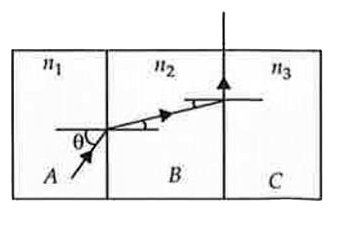A,B and C are the parallel sided transparent media of refractive index n1,n2 and n3 respectively.
The are arranged as shown in the figure. A ray is incident at an angle θ on the surface of separation of A and B which is as shown in the figure. After the refraction into the medium B, the ray grazes the surface of separation of the media B and C. Then, sinθ=  Solution in Kannada
Solution in Kannada
n3n1
n1n3
n2n3
n1n2
The correct Answer is:A

Applying Snell.s law at M,
n1sinθ=n2sinθ. . . .(i)
Again, applying Snell.s law at N
n2sinθ.=n3sin90∘
n2sinθ.=n3sin90∘ n2sinθ.=n3
n1sinθ=n3 (Using (i))
sinθn3n1
Topper's Solved these Questions
Similar Questions
In ruby laser, the stimulated emission is due to transition from
View SolutionWhich of the following graphs correctly represents the variation of heat energy (U) produced in a metallic conductor in a given time as a function of potential difference (V) across the conductor ?
View SolutionA spherical surface of radius 30 cm separates two transparent media A and B with refractive indices 1'33 and 1.48 respectively. The medium A is on the convex side of the surface. Where should a point object be placed in medium A so that the paraxial rays become parallel after refraction at the surface ?
View SolutionTwo refracting media are separated by a spherical interfaces as shown in the figure. AB is the principal axis, mu_1 and mu_2 are the refractive indices of medium of incidence and medium of refraction respectively. Then,
View SolutionA spherical surface of radius 30cm separates two transparent media A and B with refractive indiecs 1.33 and 1.48 , respectively. The medium A is on the convex side of the surface. Where should a point object the placed in medium A so that the paraxial rays become parallel after refraction at the surface?
View SolutionA rectangular glass slab ABCD of refractive index n1 is immersed in water of refractive index n2(n1<n2). A ray of light is incident at the surface AB of the slab as shwon. The maximum value of the angle of incidence αmax such that the ray comes out from the other surface CD is given by

View SolutionAn unpolarised light is incident on a surface separating two transparent media of different optical densities at the polarizing angle. Then the reflected ray and refracted ray are
View Solutionn1 तथा n2 अपवर्तनांक के दो माध्यमों को अलग करने वाले उत्तल गोलीय पृष्ट के लिये अपवर्तन सम्बन्धी सूत्र स्थापित कीजिए |
View SolutionA,B, and C are the parallel sided transparent media of refractive indices n_(1),n_(2) and n_(3) respectively. They are arranged as shown in the figure. A ray is incident at an angle i on the surface of separation of A and B which is as shown in the figure. After the refraction into the medium B the ray grazes the surfaces of separation of the media B and C. then sin i equal to
View SolutionA light ray moving in medium-I (of refractive index n_(1) ) is incident on interface of two media and it is totally internally reflected at the interface. Now, refractive index n_(2) of medium-II is decreased, then
View SolutionA ray of light passes through four transpar ent media with refractive indicesμ1,μ2,μ3 and μ4 as shown in figure. The surfaces of all media are parallel. If the emergent ray is parallel to the incident ray, we must hav

View Solutionसमांतर पृष्ठो वाले दो पारदर्शी गुटके A व B के अपवर्तनांक क्रमशः n1 व n2 है | प्रकाश किरण A व B को पृथक करने वाले पृष्ठ पर कोण θ से आपतित होती है तथा B से वायु में अपवर्तित होने के बाद B के पृष्ठ के स्पर्शतः निर्गत होती है, तब
View SolutionA spherical surface of radius 30 cm separates two transparent media A and B with refractive indices 1'33 and 1.48 respectively. The medium A is on the convex side of the surface. Where should a point object be placed in medium A so that the paraxial rays become parallel after refraction at the surface ?
View SolutionAn unpolarised light is incident on a surface separating two transparent media of different optical densities at the polarizing angle. Then the reflected ray and refracted ray are
View SolutionA ray of light passes through four transparent media with refractive index n_(1),n_(2),n_(3)andn_(4) as shown. The surface of all media are parallel If the emergent ray DE is parallel to incident ray AB, then
View Solution
